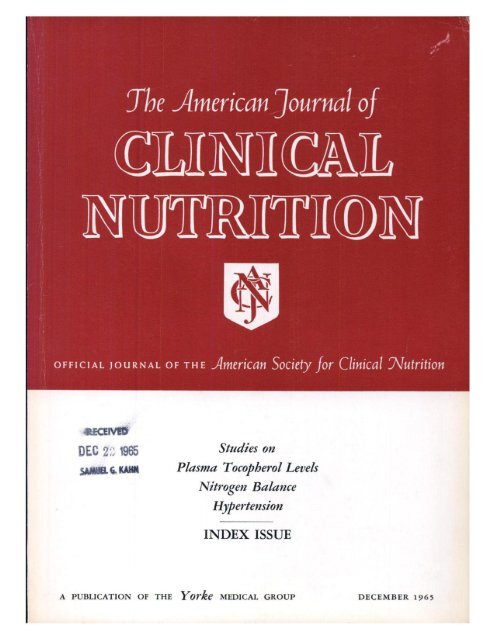Randomized dose-response trial of n–3 fatty acids in hormone receptor negative breast cancer survivors – impact on breast adipose oxylipin and DNA methylation patterns
IF 6.5
1区 医学
Q1 NUTRITION & DIETETICS
引用次数: 0
Abstract
Background
Increasing evidence suggests the unique susceptibility of estrogen receptor and progesterone receptor negative [ERPR(−)] breast cancer to dietary fat amount and type. Dietary n–3 (ω-3) polyunsaturated fatty acids (PUFAs), such as docosahexaenoic acid (DHA) and eicosapentaenoic acid (EPA), may modulate breast adipose fatty acids and downstream metabolites to counteract procarcinogenic signaling in the mammary microenvironment.
Objectives
We aimed to determine effects of ∼1 to 5 g/d EPA+DHA over 12 mo on breast adipose fatty acid and oxylipin profiles in survivors of ERPR(−) breast cancer, a high-risk molecular subtype.
Methods
We conducted a proof-of-concept 12-mo randomized double-blind trial comparing ∼5 g/d and ∼1 g/d EPA+DHA supplementation in females within 5 y of completing standard therapy for ERPR(−) breast cancer Stages 0 to III. Blood and breast adipose tissue specimens were collected every 3 mo for fatty acid, oxylipin, and DNA methylation (DNAm) analyses.
Results
A total of 51 participants completed the 12-mo intervention. Study treatments were generally well tolerated. Although both doses increased n–3 PUFAs from baseline in breast adipose, erythrocytes, and plasma, the 5 g/d supplement was more potent with differences (% total fatty acids) of 0.76 (95% confidence interval [CI]: 0.56, 0.96), 6.25 (95% CI: 5.02, 7.48), and 5.89 (95% CI: 4.53, 7.25), respectively. The 5 g/d dose also reduced plasma triglycerides from baseline, with changes (mg/dL) of 27.38 (95% CI: 10.99, 43.78) and 24.58 (95% CI: 9.05, 40.10) at 6 and 12 months, respectively. Breast adipose oxylipins showed dose-dependent increases in DHA and EPA metabolites. Distinct DNAm patterns in adipose tissue after 12 mo suggest potential downregulation of aberrant lipid metabolism pathways at the 5 g/d dose.
Conclusions
Over 1 y, EPA+DHA dose-dependently increased breast adipose concentrations of these fatty acids and their derivative oxylipin metabolites and produced differential DNAm profiles involved in metabolism-related pathways critical to ERPR(−) breast cancer development. This distinct metabolic and epigenetic modulation of the breast microenvironment is achievable with high-dose n–3 PUFA supplementation.
This trial was registered at clinicaltrials.gov as NCT02295059.
n-3脂肪酸在激素受体阴性乳腺癌幸存者中的随机剂量反应试验-对乳腺脂肪氧脂和DNA甲基化模式的影响。
背景:越来越多的证据表明雌激素受体和孕激素受体阴性[ERPR(-)]乳腺癌对膳食脂肪的数量和类型具有独特的易感性。饮食中的n-3 (ω-3)多不饱和脂肪酸(PUFAs),如二十二碳六烯酸(DHA)和二十碳五烯酸(EPA),可能会调节乳腺脂肪脂肪酸和下游代谢物,从而抵消乳腺微环境中的致癌前信号。目的:我们旨在确定在12个月的时间内,1 ~ 5 g/d EPA+DHA对ERPR(-)乳腺癌(一种高风险分子亚型)幸存者乳腺脂肪脂肪酸和氧脂质谱的影响。方法:我们进行了一项为期12个月的概念验证性随机双盲试验,比较了在完成ERPR(-)乳腺癌0期至III期标准治疗后5年内,女性补充~ 5 g/d和~ 1 g/d EPA+DHA的情况。每3个月采集一次血液和乳房脂肪组织标本,进行脂肪酸、氧脂素和DNA甲基化(DNAm)分析。结果:共有51名参与者完成了为期12个月的干预。研究治疗通常耐受性良好。尽管两种剂量均使乳腺脂肪、红细胞和血浆中的n-3 PUFAs较基线增加,但5 g/d补充剂的效力更强,差异分别为0.76(95%可信区间[CI]: 0.56, 0.96)、6.25 (95% CI: 5.02, 7.48)和5.89 (95% CI: 4.53, 7.25)。在6个月和12个月时,5 g/d剂量也降低了血浆甘油三酯,分别为27.38 (95% CI: 10.99, 43.78)和24.58 (95% CI: 9.05, 40.10)。乳腺脂肪氧化脂显示DHA和EPA代谢物的剂量依赖性增加。12个月后脂肪组织中不同的DNAm模式表明在5 g/d剂量下可能下调异常脂质代谢途径。结论:超过1年,EPA+DHA剂量依赖性地增加了这些脂肪酸及其衍生物氧脂代谢产物的乳腺脂肪浓度,并产生了参与ERPR(-)乳腺癌发展关键代谢相关途径的差异DNAm谱。这种独特的代谢和表观遗传调节乳房微环境是可以实现的高剂量n-3 PUFA补充。该试验在clinicaltrials.gov注册为NCT02295059。
本文章由计算机程序翻译,如有差异,请以英文原文为准。
求助全文
约1分钟内获得全文
求助全文
来源期刊
CiteScore
12.40
自引率
4.20%
发文量
332
审稿时长
38 days
期刊介绍:
American Journal of Clinical Nutrition is recognized as the most highly rated peer-reviewed, primary research journal in nutrition and dietetics.It focuses on publishing the latest research on various topics in nutrition, including but not limited to obesity, vitamins and minerals, nutrition and disease, and energy metabolism.
Purpose:
The purpose of AJCN is to:
Publish original research studies relevant to human and clinical nutrition.
Consider well-controlled clinical studies describing scientific mechanisms, efficacy, and safety of dietary interventions in the context of disease prevention or health benefits.
Encourage public health and epidemiologic studies relevant to human nutrition.
Promote innovative investigations of nutritional questions employing epigenetic, genomic, proteomic, and metabolomic approaches.
Include solicited editorials, book reviews, solicited or unsolicited review articles, invited controversy position papers, and letters to the Editor related to prior AJCN articles.
Peer Review Process:
All submitted material with scientific content undergoes peer review by the Editors or their designees before acceptance for publication.

 求助内容:
求助内容: 应助结果提醒方式:
应助结果提醒方式:


